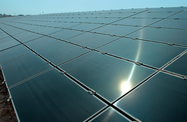In mid-January 2012, Dubai unveiled the details of a massive solar energy facility it plans to build in the desert, part of a larger scheme to meet the energy needs of the emirate and reduce its reliance on imported natural gas to fire its power stations.
Under the programme outlined by officials, Dubai is to invest $3.2bn to develop one of the region’s largest solar power plants, the Mohammed bin Rashid Al Maktoum Solar Park, to be built on a 48-sq-km site at Seih Al Dahal in the south-east of the emirate.
The first stage of the project will be fast tracked, with tenders for the developer of the solar park scheduled to be opened in June. The initial stage of the facility, a 10-MW array using photovoltaic technology, is listed to be completed and start feeding into the power grid by late 2013. The later stages of the project, which will be finished by 2030, will utilise the more advanced concentrated solar power (CSP) technology, which will generate 1000 MW of energy.
According to Saeed Mohammed Al Tayer, the vice-chairman of the state’s Supreme Council of Energy (SCE) and the chief executive officer of the Dubai Electricity and Water Authority (DEWA), the solar park will help power the economy and reduce Dubai’s carbon footprint.
“The Mohammed bin Rashid Al Maktoum Solar Park is an advanced model of power production, which achieves our leaders’ aspirations to diversify sources of energy, specifically by using renewable energy to conserve resources and protect the environment from pollution,” he said. “This solar park will significantly enhance our efforts to achieve sustainable development.”
Along with the government’s programme to expand the emirate’s power-generation capacity, Dubai is also seeking to curb growing demand, which is currently rising by around 5% a year. The state has been encouraging citizens to cut back on electricity consumption and install environmentally friendly technology in their homes. The government has also been promoting the use of green technology in office, retail and large-scale property developments. These measures were designed to help Dubai meet its goal of reducing carbon emissions by 30% over the next two decades.
The solar programme may well offer opportunities for investors, with Al Tayer flagging the possibility of opening up the project to the private sector. While the SCE will find the funding for the first stage of the development, the head of DEWA said there was interest from investors in the programme to diversify Dubai’s electricity generation sector. So far, details on how the project will be funded have not been made public, though Dubai has made use of the international bond market to underpin other major public works schemes.
While the project may offer direct investment opportunities, it also has the potential to bolster local industry through the transfer of skills, knowledge and technology to domestic companies and via subsidiary supply agreements with the lead contractors.
Though solar energy will be a useful contributor to Dubai’s power mix, it will be a relatively small one. By 2020, just 1% of the emirate’s electricity needs will be met by solar power, rising to 5% by 2030, when the Mohammad Bin Rashid Al Maktoum Solar Park facility is fully on-line. This is less than half the contribution of Dubai’s planned nuclear energy plant or its expected coal-fired power stations. Together, these three sources are projected to meet 29% of Dubai’s electricity needs by 2030, with the balance coming from gas-fired power stations, fuelled by imported feed stock.
Currently, 99% of the emirate’s electricity is generated by using gas to fire the power stations, with the remaining 1% coming from fuel oil-fired plants, though a number of private developments already make use of solar power, with an estimated 4.5 MW of capacity installed. To help keep pace with the growing demand and build up an excess in output to cope with spikes on the grid, DEWA increased its generation capacity by 18% in 2011, boosting production capability to 8718 MW.
The proposed solar park will boost Dubai’s green credentials, as well as provide a useful addition to its electricity generation capacity, while ensuring the emirate can reduce its gas imports and meet domestic energy demands.

